Research projects undertaken by PAMA – Institute for the Advancement of Transdisciplinary Archaeological Sciences (IATAS) independently or in collaboration with Universities or other academic institutions will be a platform for participation in transdisciplinary research, internship etc.
In 2018, following an inspection of PAMA, the Archaeological Survey of India (ASI) granted excavation permissions for the years 2019-2020 and 2021-2022, with Dr. P.J. Cherian at the helm as the Principal Investigator (PI) and Director to lead the continued excavations at Pattanam. Previously, from 2007 to 2015, Dr. Cherian served as the PI and Director of Pattanam excavations while also holding the position of Director at the Kerala Council for Historical Research (KCHR).
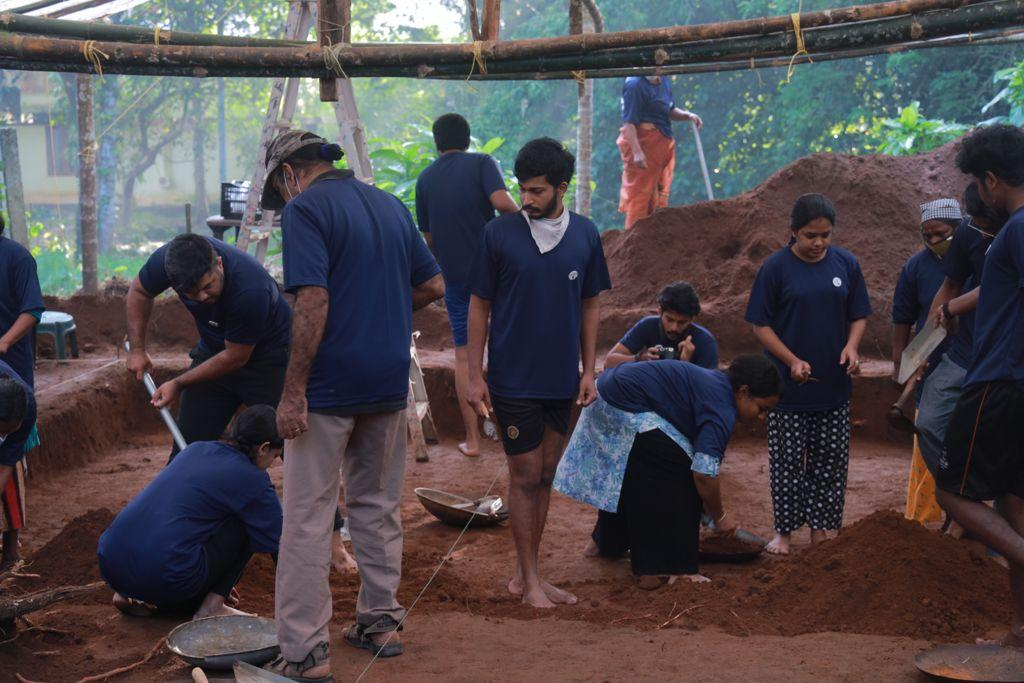
Image credit: Sanjoe Joseph, 2021
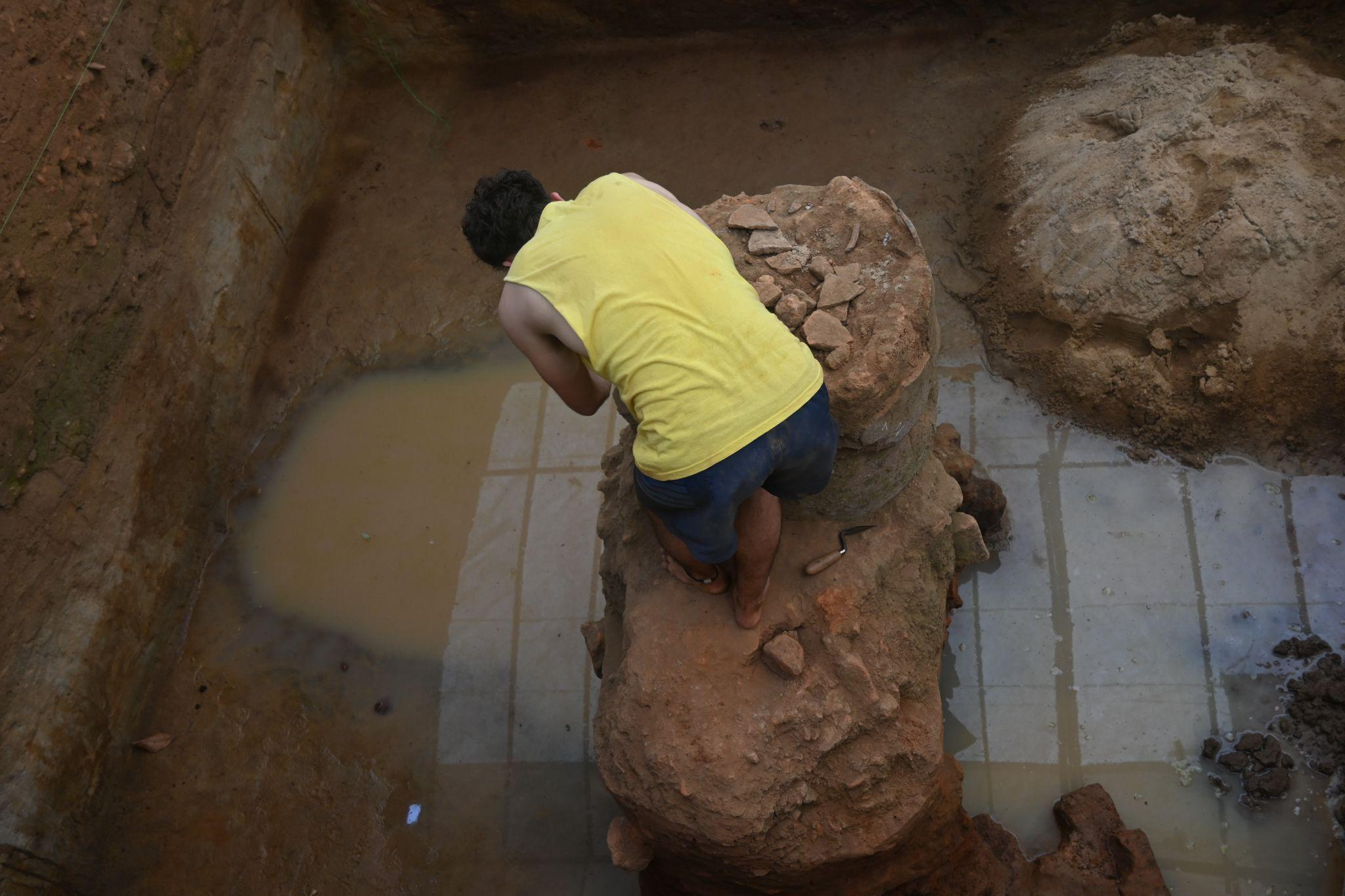
Excavating a Ring well structure
Image credit: Dheeraj Sharma, 2023
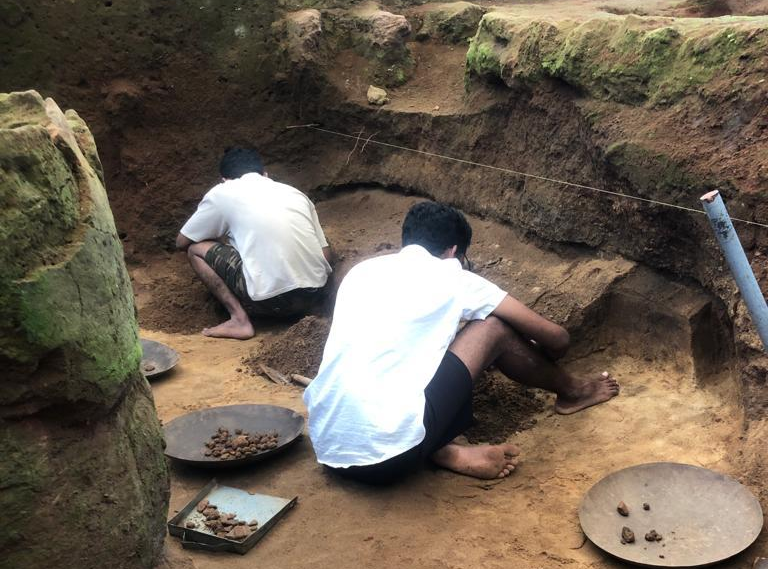
Carefully sorting through sand looking for artefacts
Image credit: PJ Cherian, 2023
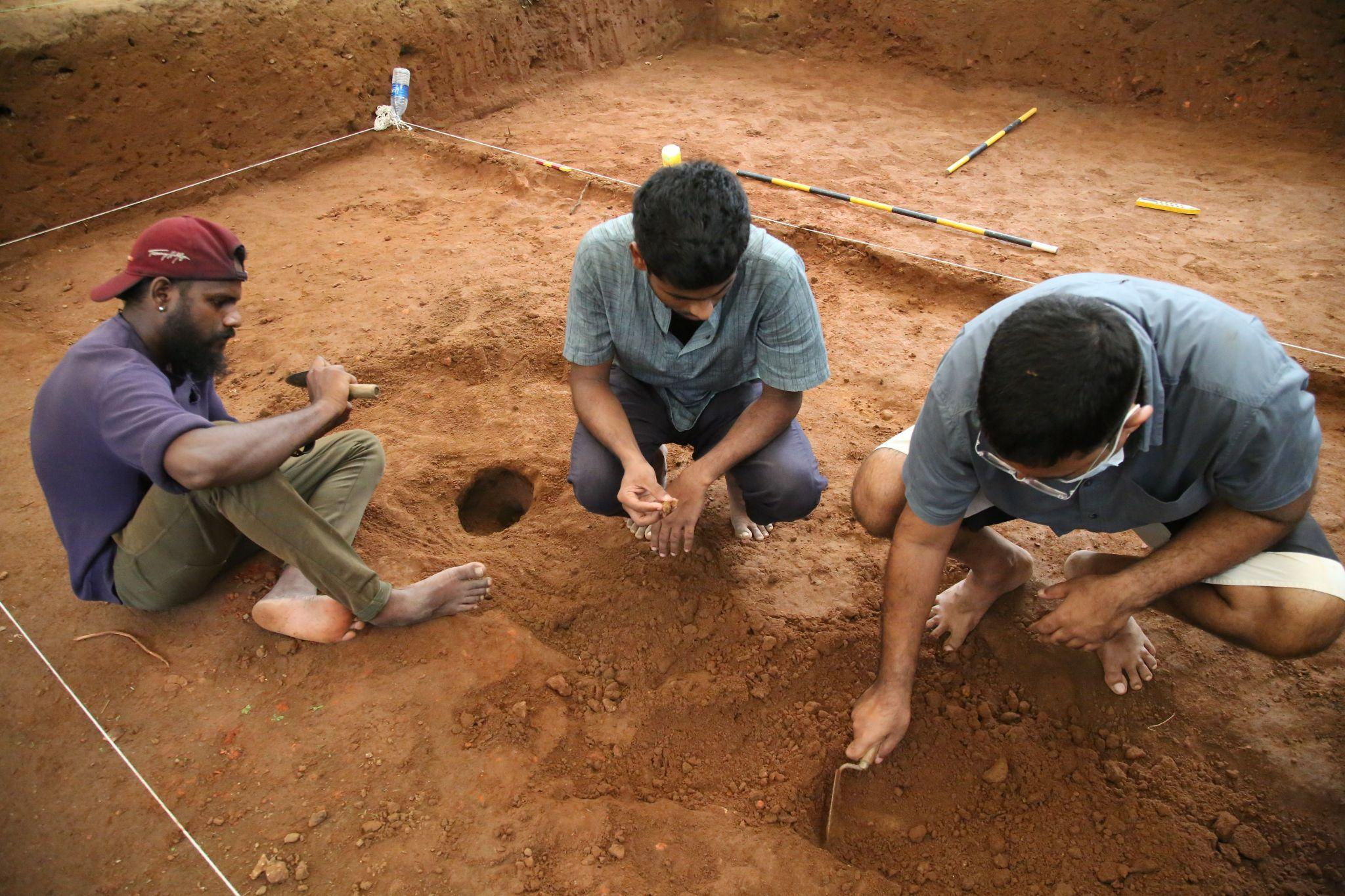
Digging using a trowel
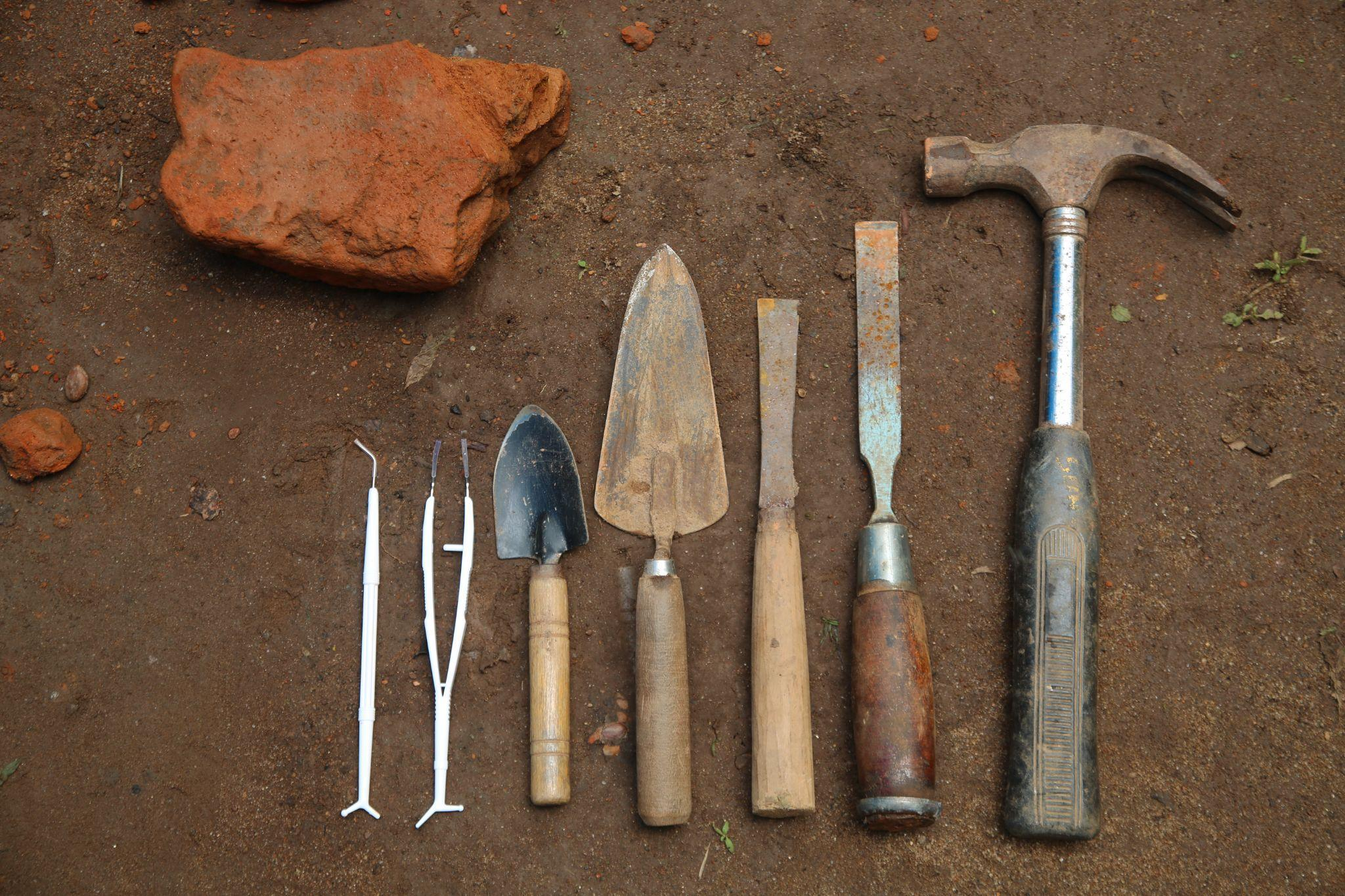
Different tools used in excavation
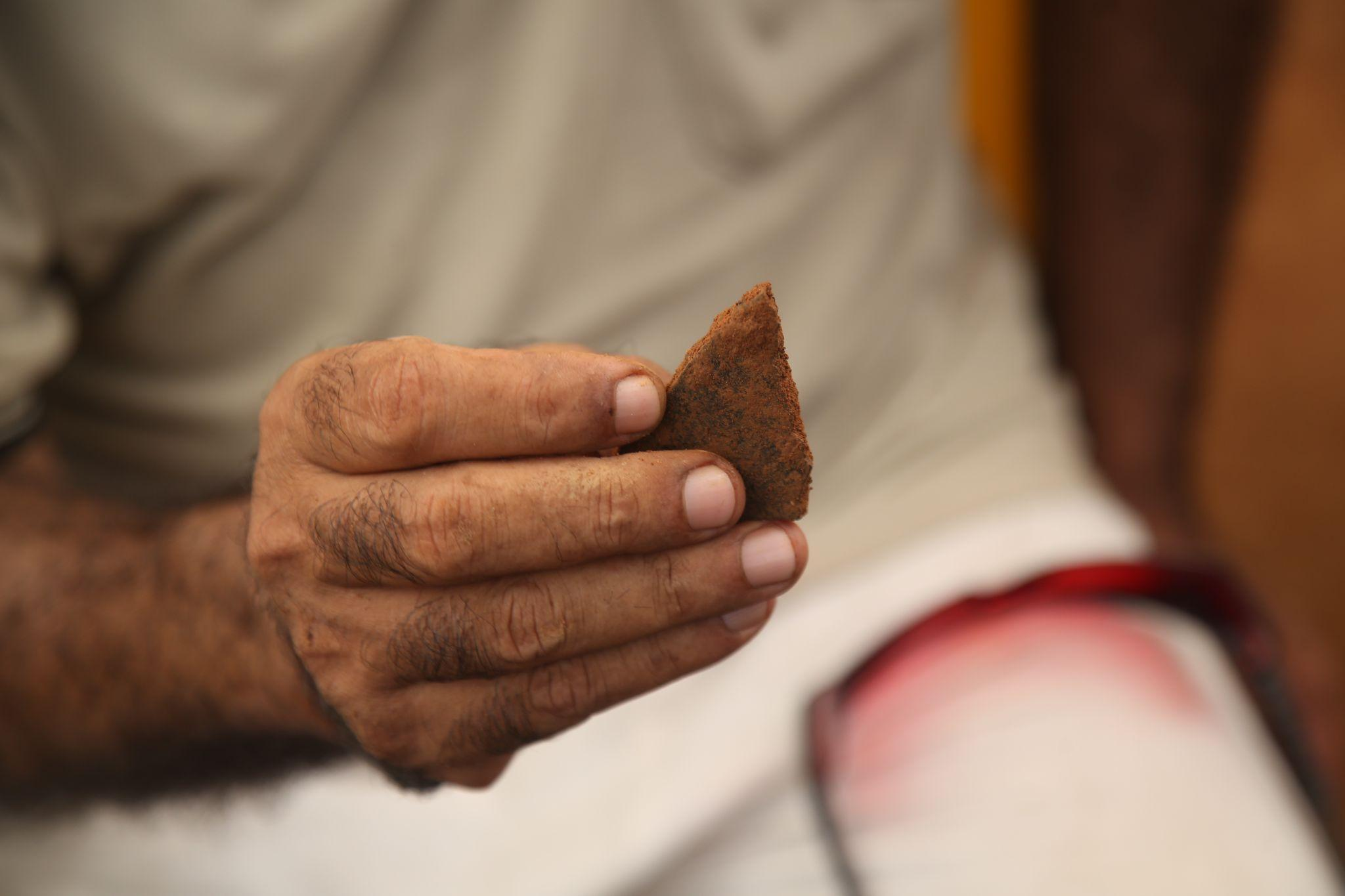
A pot sherd
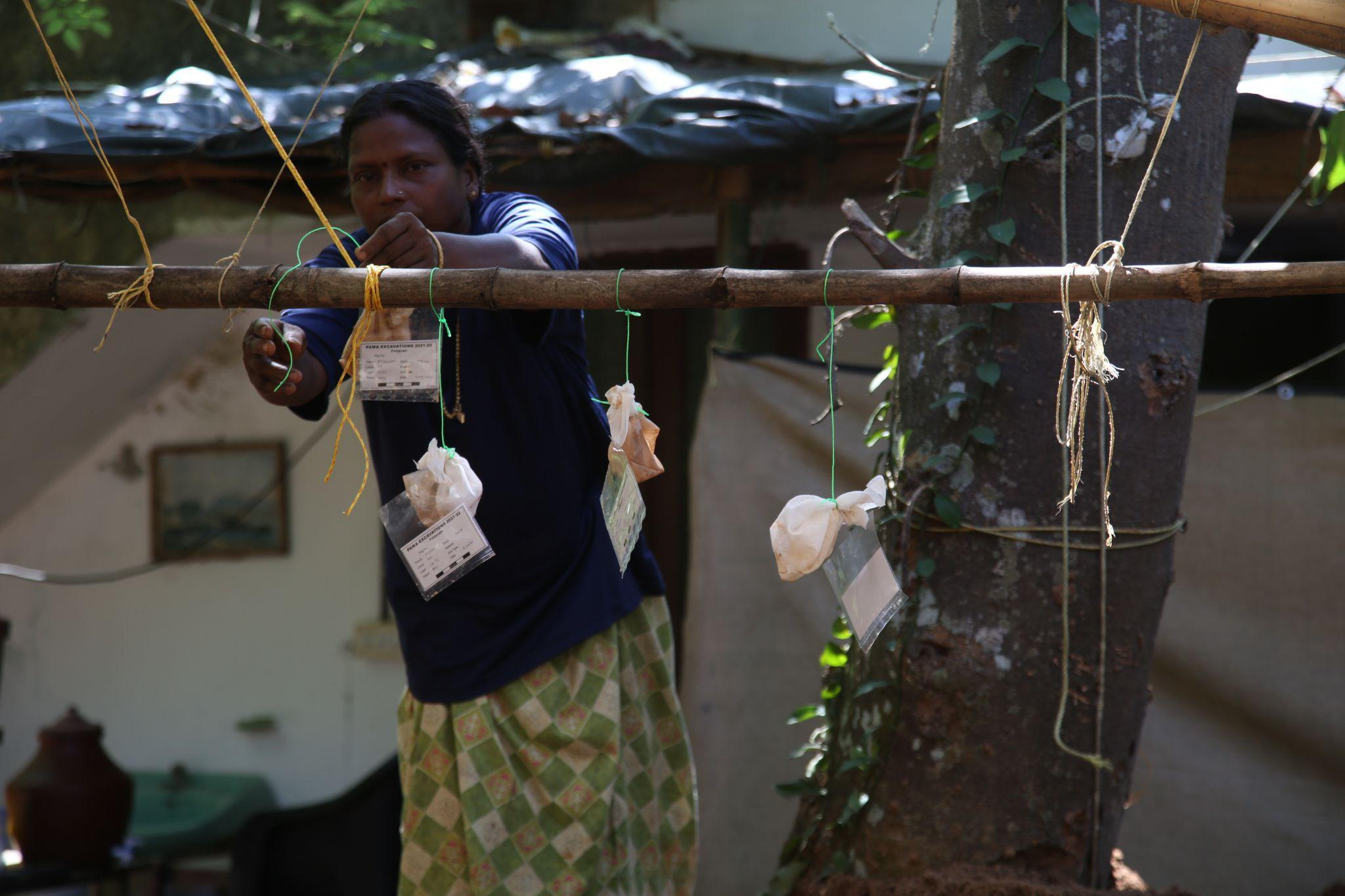
Hanging floatation samples for drying
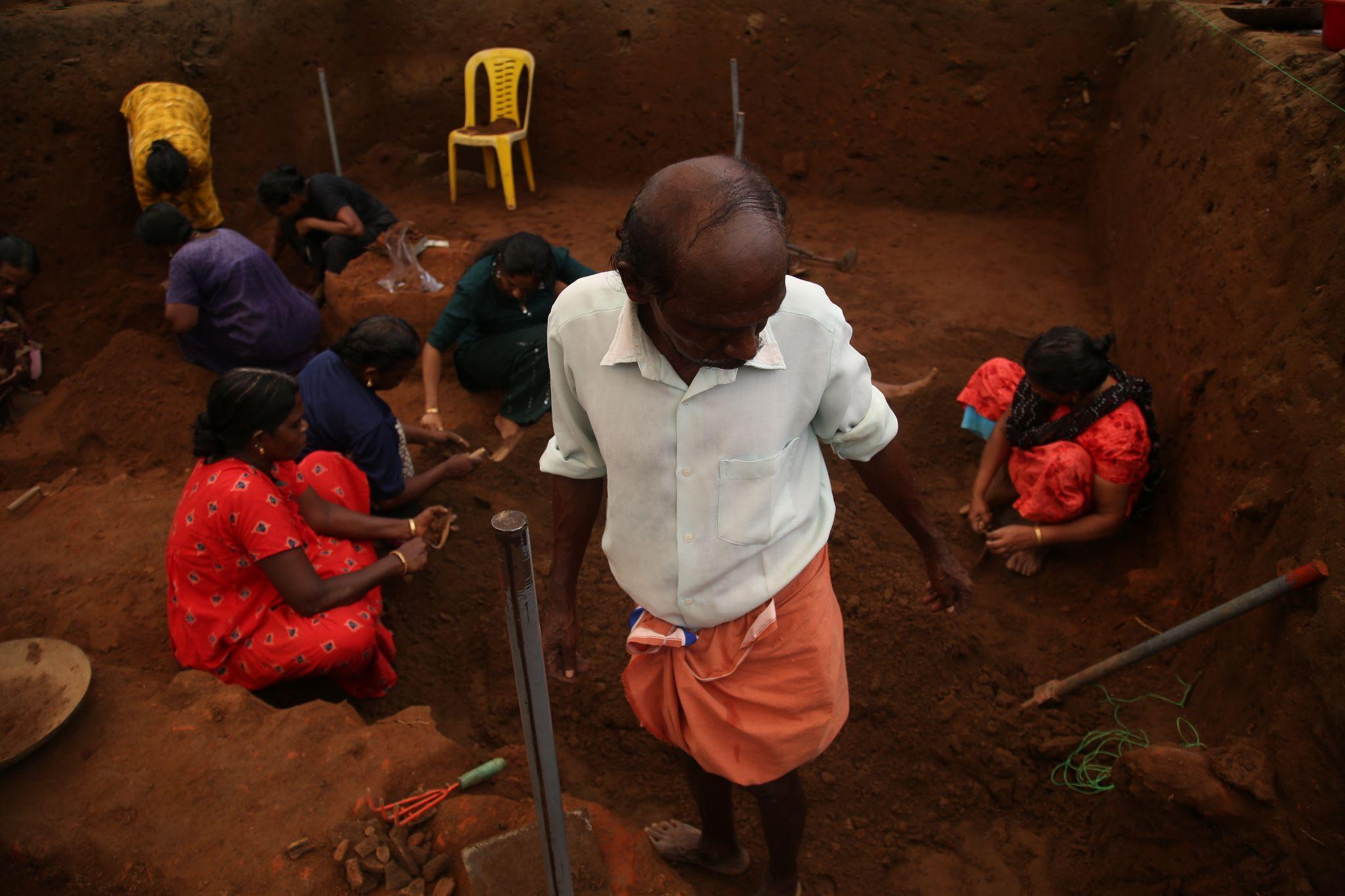
Sorting through dug soil looking for material finds
Image credit: Sibi Manjali, 2022
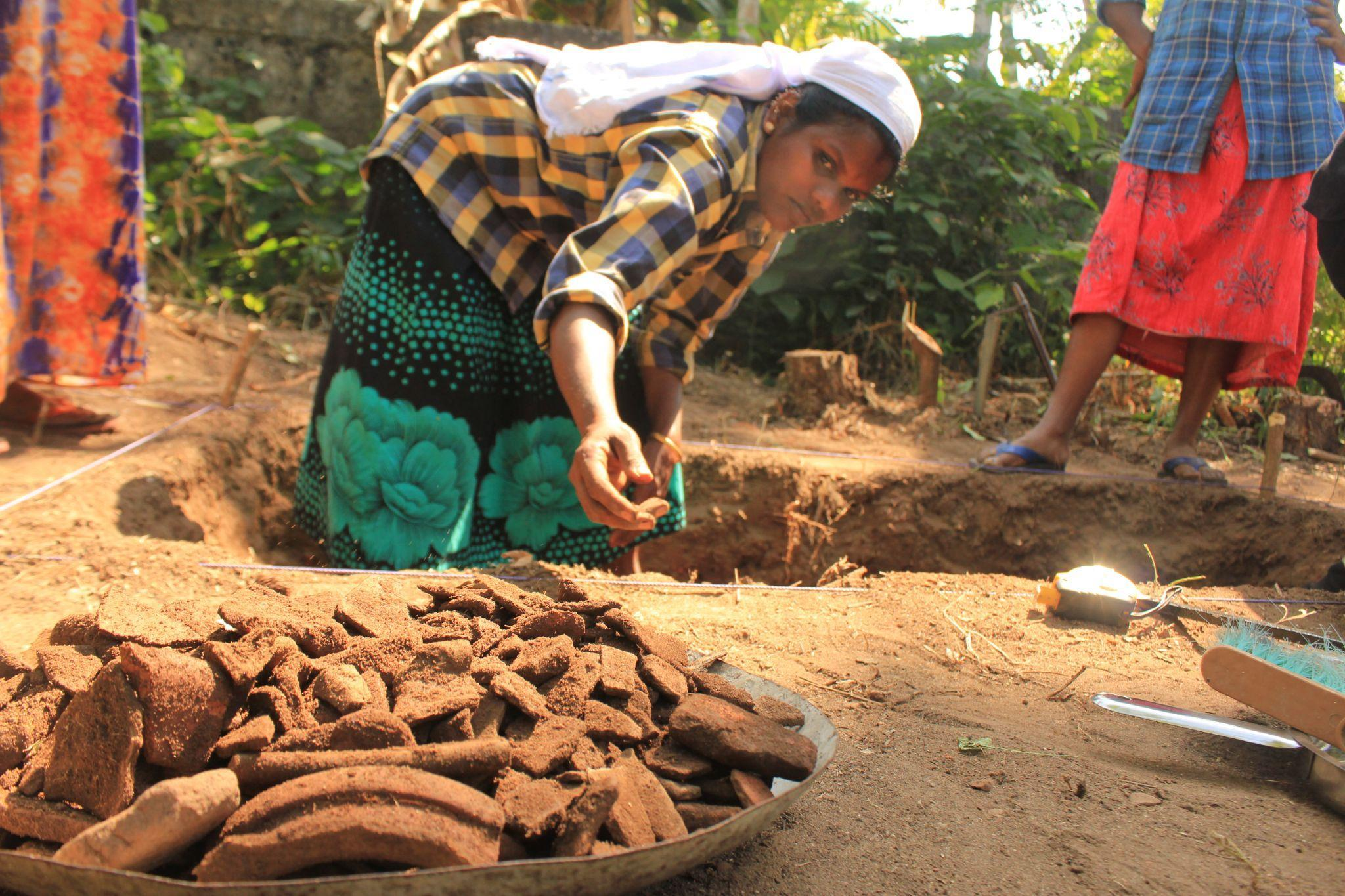
Collecting pot sherds in a chatti
Pama excavated six trenches (Trench 62 - 67) in Pattanam between 2019 and 2023 following the research protocols of Pattanam archaeological research started in 2007. Further, in 2020 excavations were also conducted in Mathilakam, sixteen kilometres north of Pattanam.
The 10th (2019-2021) and 11th (2021-2023) seasons of excavation unearthed important artefacts including Pottery and beads of different variety and provenance, iron implements, copper and lead remains, worked stones, structural remains such as bricks, roofing tiles, ring wells etc. and other contextual evidence for metallurgical, lapidary, and possible minting workshop. A seal ring with the intaglio of a Greek She-Sphinx (PT21 LXV), with the motif bearing a close resemblance to the image of she sphinx on the seal ring of Augustus Caesar, the first Roman Emperor; and A miniature Greco-Roman head statuette (PT21 LXV) excavated in the same season that has been identified with Roman emperor Domitian (81 C.E. - 96 C.E.) reiterates that the extent of exchanges were not limited to utilitarian products with the Mediterranean world.
List of trenches excavated
PT20 LVII
PT20 LXIII
PT20 LXIV
PT20 LXV
PT20 LXVI
PT22 LXVII
The excavated materials are stored between the PAMA facility in Pattanam and the local bank locker. We invite collaborations for pre and post excavation studies, and research proposals from students, researchers, and institutes. Contact us
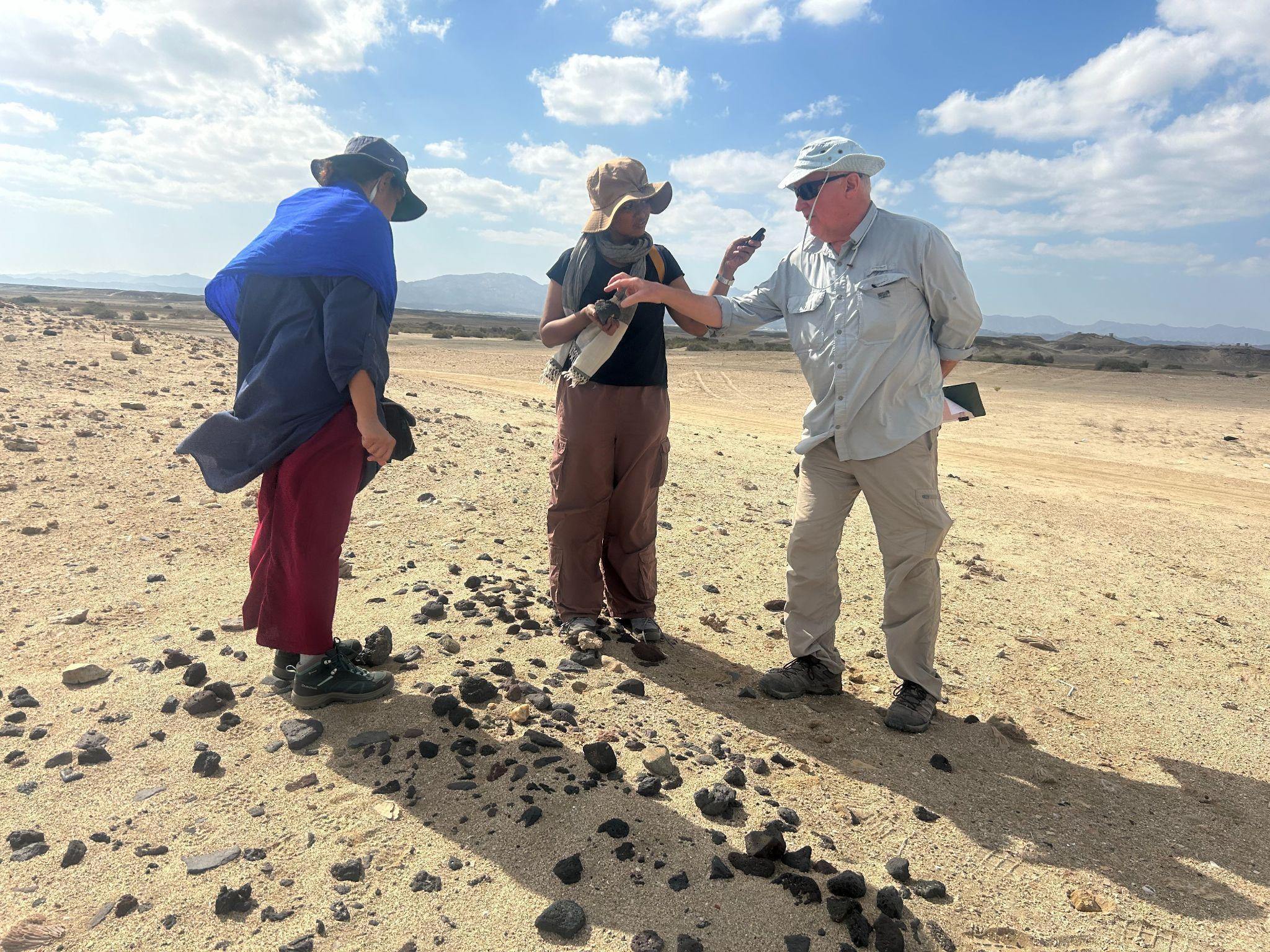
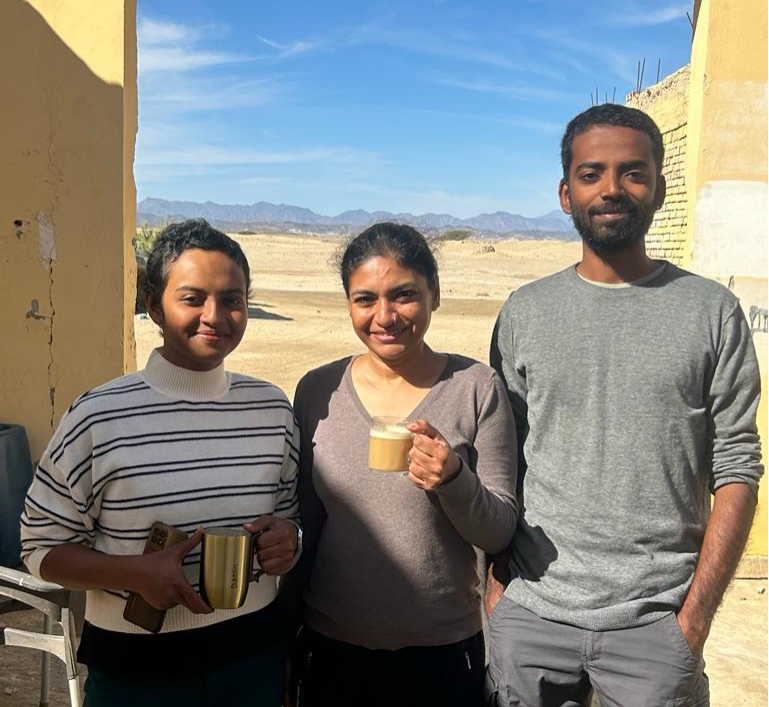
PAMA team in Berenike, 2024
PAMA team in Berenike, 2024
Berenike is located (23º 54.62’ N/35º 28.42’ E) on the Red sea coast of Egypt.
Ptolemy II Philadelphus (285/282-246 BC) founded Berenike sometime in the second quarter of the third century BC,
or perhaps somewhat earlier, as part of a broader infrastructure initiative of road building in the Eastern Desert of Egypt,
of canal construction from the Nile to the Red Sea and port foundations along the African coast of the Red Sea.
4 Procurement of elephants for military purposes and acquisition of gold and ivory from areas of what are today Sudan
and Eritrea were the initial reasons for Berenike’s foundation. Gradually, commercial relations with southern Arabia and,
on a much more limited scale, with areas of the northwestern Indian Ocean followed. Berenike’s zenith under the Ptolemies
was the mid-third to mid-second century BC. Thereafter, it seems to have languished until the advent of the Romans.
Following the Roman acquisition of Egypt in 30 BC. Berenike’s fortunes, especially in the first and second century AD,
rose to new heights. Literary and, more so, archaeological evidence, indicates extensive commercial and cultural contacts
extending as far west as the Iberian Peninsula and northwestern Africa on the one hand and the Near East, Red Sea, southern
Arabia and South Asia (India and Sri Lanka) on the other on a regular basis (Steven Sidebothan and Iwona Zych et al.)
Source: Steven E. Sidebotham, et. al. Thetis, Band 24, 2029
In 2024, a four-member team from PAMA joined the excavations at Berenike to advance collaborations in field studies and to exchange and acquire state-of-the-art archaeological practices, with formal approval from the relevant authorities. The 2024 Berenike excavation was a collaborative effort involving the University of Delaware (USA), Heidelberg University (Germany), and the Polish Centre for Mediterranean Archaeology.
Berenike, a contemporary port site to Pattanam, is evidenced by both archaeological findings and literary sources to have been a mutual destination in antiquity.
Excavations at Berenike over the years have revealed numerous artefacts connecting it to South India, including Tamil Brahmi inscriptions,
jars of pepper, and evidence of teak wood and its recycled usage. The mission provided an opportunity to examine this evidence more closely.
PAMA further aims to facilitate and collaborate to undertake studies and field research on contemporary sites of Pattanam (peak phase: 300 BCE. - 300 CE.) and on the early historic maritime network.
Pre excavation/ excavation/ post excavation studies have been initiated by the PI or our team members on the following sites over the years -
Hepu, Guangzhou, and Quanzhou (South China)
Khao Sam Kaeo (Upper Thai-Malay Peninsula)
Tamralipti, Arikamedu/VeeramPattinam, Korkai, Alagankulam (Tamil Nadu, India)
Anuradhapura, Tissamaharama, Manthai (Sri Lanka)
Barygaza/Bharuch, Sanjaan (Gujarat, India)
Khor Rori/Sumhuram, Al Baleed (Oman)
Thebes, Athens, Crete, Delos, Rhodes, Koa (Greece)
Paleopolis, Rome, Pompeii, Naples (Italy)
Gaul (France)
Baetica (Spain)

Stone slabs
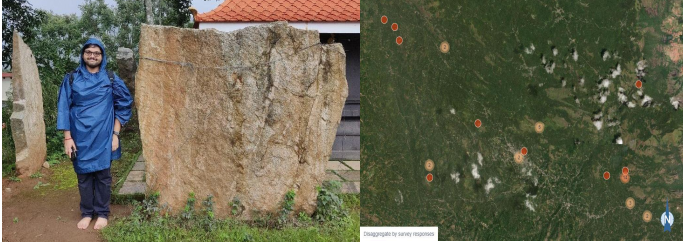
A relocated Hood stone/Menhir (left). Locations recording potential sites of archaeological significance after preliminary survey (right)
PAMA’s exploration activities include archaeological and ethnoarchaeological surveys on the Periyar river basin.
Periyar is understood to have had an important role in shaping the life of the early settlers in this region, one reason for this assumption is the location of Pattanam at the mouth of the river itself and the identification of Iron age monuments in the higher altitudes of the western ghats. We also know from historical records and historical consciousness that Periyar continued to play a crucial role in defining the settlement patterns in this area. However, the river Periyar in the last two thousand years is understood to have undergone changes in its course and nature. Therefore, a wider exploration of the river basin is necessary for locating pre modern human activities in the region.
Archaeological survey systematically locates and records the presence of archaeological sites and artefacts within a specific area. This non-invasive method involves examining the surface features, often using tools such as maps, aerial photographs, and satellite imagery, to identify potential sites of interest. PAMA’s surveys are often conducted on foot. Surveys can employ the use of advanced technology like drones and geophysical instruments. The objective of these exploration activities are to (1) identify, and (2) document information about the distribution and density of cultural remains across a landscape, which can help guide further excavation and research efforts. By mapping and documenting these findings, we can gain valuable insights into the past human activities, settlement patterns, and the environmental conditions of different historical periods.
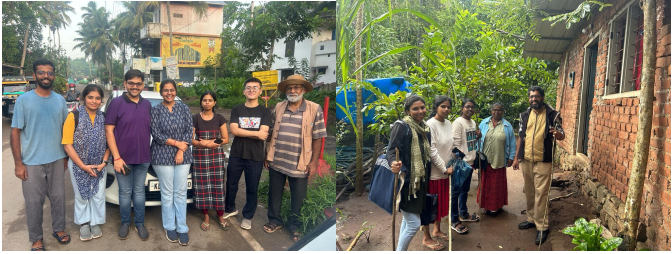
Stone slabs
An exploratory survey conducted in the months of November-December of 2006 in the Kadungalloor and Paravoor taluks by a team, comprising over fifty members from different parts of India led to the subsequent excavations in the Pattanam village.
The Periyar River valley has been a site of continuous human activity for thousands of years, a fact conclusively demonstrated by archaeological excavations at Pattanam since 2006-07. Evidence from Pattanam suggests that the Muziris port, situated on the Periyar delta, had maritime interfaces from 300 BCE to 300 CE. The Idukki region, or the upper Periyar basin, is part of the mountainous area referred to as Kurinji thinai, an ecozone noted in classical literature. This region likely played a crucial role in supplying resources that contributed to Muziris becoming known as "the first emporium of India." It is believed that Iron Age remains from around 1000 BC exist in this area.
Additionally, a significant east-west trade route passed through the Idukki Kurinji zone, linking Alagankulam at the mouth of the Vaigai River on the Bay of Bengal with Pattanam at the mouth of the Periyar River on the Arabian Sea. Several sites have already been identified along the Vaigai river, including the Pandya capital city of Madurai, various trade centres, industrial sites, Jain sites, Roman and Punch Marked Coin (PMC) hoard sites, and numerous memorial stone sites. Excavations at Keeladi have further illuminated the Vaigai-Periyar cultural and trade corridor in peninsular India and beyond. The Idukki region was a major supplier of forest goods, such as pepper, cardamom, medicinal plants, and ivory, which likely boosted both domestic and transcontinental trade during the early historic period (500 BCE - 500 CE).
The aim of the Idukki Exploration Project is to locate, map, and document the remnants of early human settlements and gather ethnoarchaeological data through systematic pedestrian surveys.
The Idukki District Exploration 2023 is conducted under the auspices of the PAMA Research Institute, with legally mandated permissions from the Archaeological Survey of India. This extensive, ongoing project is being undertaken in collaboration with local and district-level governments, various government agencies, and educational institutions within and beyond Idukki district and is scheduled for completion in 2027.
The exploration is conducted as a pedestrian survey with the help of trained citizen scientists and the data collection is done with the help of prepared questionnaires through an ODK application installed on android phones. The application supports both recording of audio and video information as well as location data. It will help the volunteers collect the relevant information to a single database with little hassle.
Trained Volunteers/CSs along with the research team equipped and trained in the use of the ODK application will conduct the preliminary data collection in the 52 Panchayaths in the district. This will help the project to cover large areas in a relatively shorter time frame.
Interested individuals, students, and institutions are invited to participate in the pedestrian survey.
The pilot survey was conducted in the Nedumkandam panchayat in Idukki district in collaboration with CPAS CTE
Nedumkandam (B.Ed College) in July-August months of 2023. Click here
The collected data are available for further analysis,
and plans are underway to expand the exploration to other areas within Idukki.
Periyar River Valley Surface Survey Project (PRVSSP) for Historical, Archaeological, and Anthropological Evidence (2017-2022)
The archaeological research at Pattanam, conducted between 2007 and 2015, has provided significant insights into the growth of an urban settlement in the Periyar delta region around 2,000 years ago. Building on these findings, the PRVSS Project aims to document the remaining historical, archaeological, and anthropological evidence in the Periyar River valley region, with a focus on uncovering the origins and extent of the Periyar River Valley urban culture.
The first phase, completed during 2017–2018, covered the areas of Kalady, Manjapra, and Ayyampuzha Panchayats.
The project's second phase aimed to cover Periyar riverine Panchayats of Vadakkekara, Chittattukara, Chendamangalam, Puthenvelikara, Kottuvally, Varapuzha, Ezhikkara, Kunnukara, Karumalloor, and Pallipuram, as well as in the municipalities of Aluva and Paravur (PAMA hopes to carry out the second phase in collaboration with LSGDS and other interested local institutions).
The PRVSS Project aims to document the existing archaeological evidence in the Periyar River valley region to explore the full extent of the urban culture revealed at Pattanam. The PAMA Research Institute intends to conduct scientific documentation and systematic study of these findings. Furthermore, PAMA seeks to encourage and support local Panchayats, libraries, cultural organisations, and individuals in the conservation and display of these artefacts in their local museums. Click here
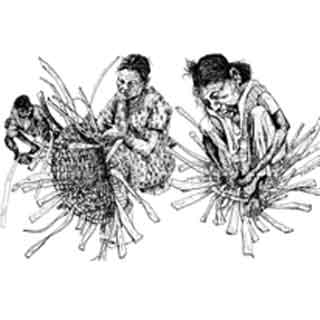
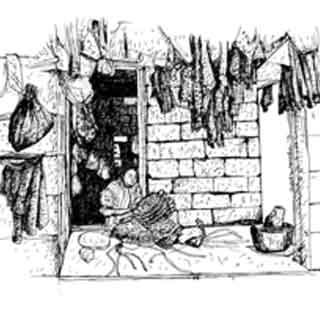
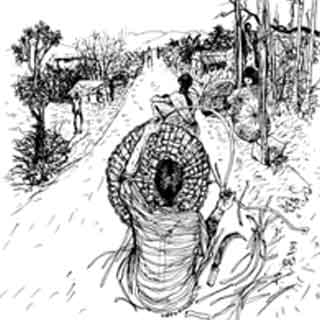

Life of the Koragu colony
The Koragu community residing in the Perdala area near Badiyadukka in Kasaragod comprises approximately 25 families, totaling around 150 individuals. Although this community is geographically located within Kerala, its members speak Tulu. Despite their proximity to mainstream society, the Koragu lead a lifestyle that is markedly isolated. They continue traditional practices handed down through generations, specifically in the production of household items such as *muram* and *arivatti*. These items are crafted from raw materials gathered from the surrounding forests, supplemented by goods purchased from local markets.
The community's economic activities are conducted on a daily basis, with all able members contributing to the production process. The products are sold locally, and the modest earnings are utilised to procure essential food items. This daily cycle of raw material collection, weaving, sales, and purchases ensures a subsistence-level existence with no capacity for saving or future planning. The community's diet primarily consists of *kanji* (rice gruel), consumed twice daily, reflecting a life centred around immediate survival rather than long-term prosperity.
The conditions faced by the children of the Koragu community are particularly concerning. Although a local school exists, it is staffed by a single teacher, and the children’s living conditions are characterised by a lack of basic amenities, insufficient nutrition, and inadequate medical care.
The objective of this project is to enhance the overall well-being of the Koragu community through culturally sensitive and scientifically informed interventions. The project will prioritise improvements in the health and educational conditions of the children. The scientific documentation of the Koragu community’s ethnohistorical context is a key academic aim of the initiative. A transdisciplinary team, in collaboration with local self-governments and academic institutions in the district, will undertake this comprehensive study.
Salvage archaeology plays a crucial role in protecting, recording, and studying archaeological remains that are at risk of being destroyed due to activities such as construction and farming… This field of archaeology aims to rescue valuable information that might otherwise be lost, documenting displaced materials and assessing their original context amid ongoing disturbances.
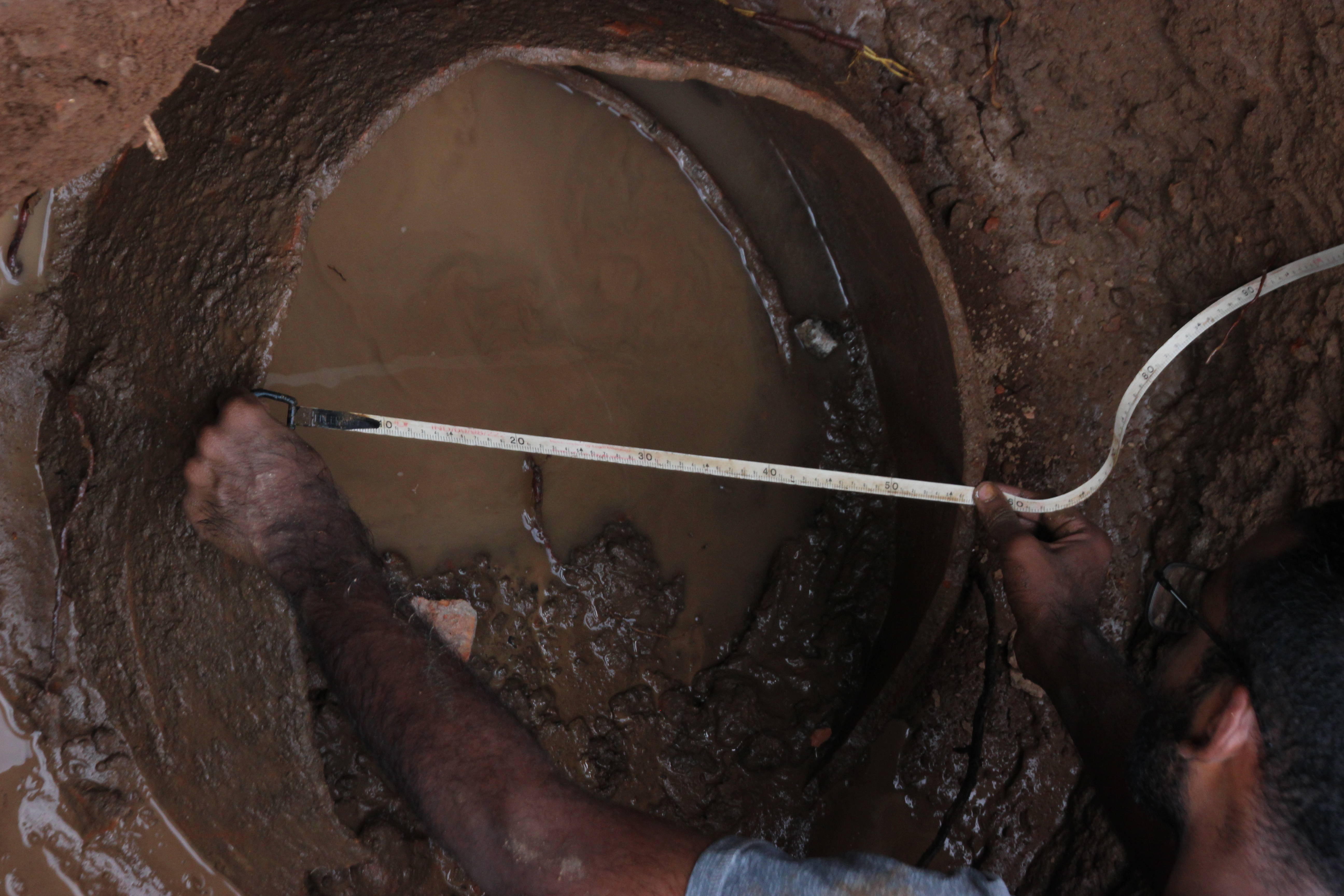
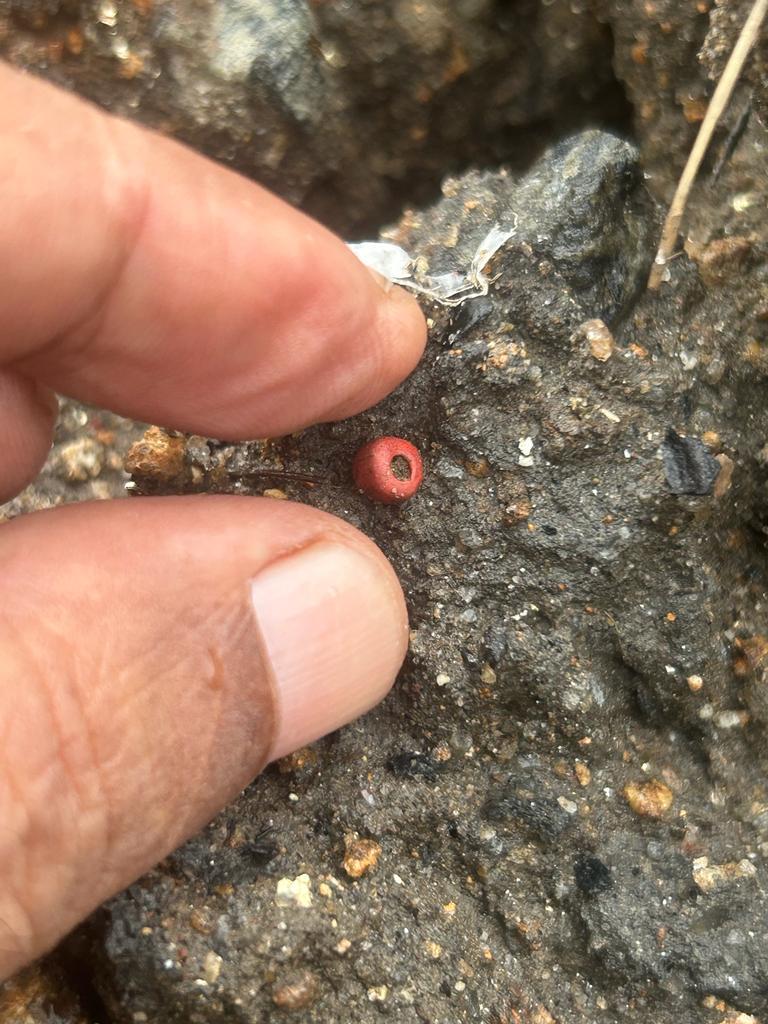
Measuring a ring well exposed during construction (left). Beads can be spotted while moving earth for construction. Bead spotted near the construction of the new highway running through the periphery of the archaeological mound (right)
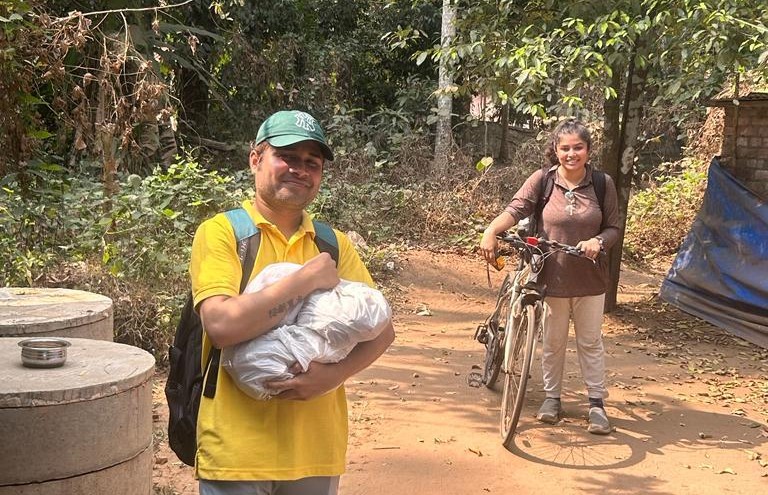
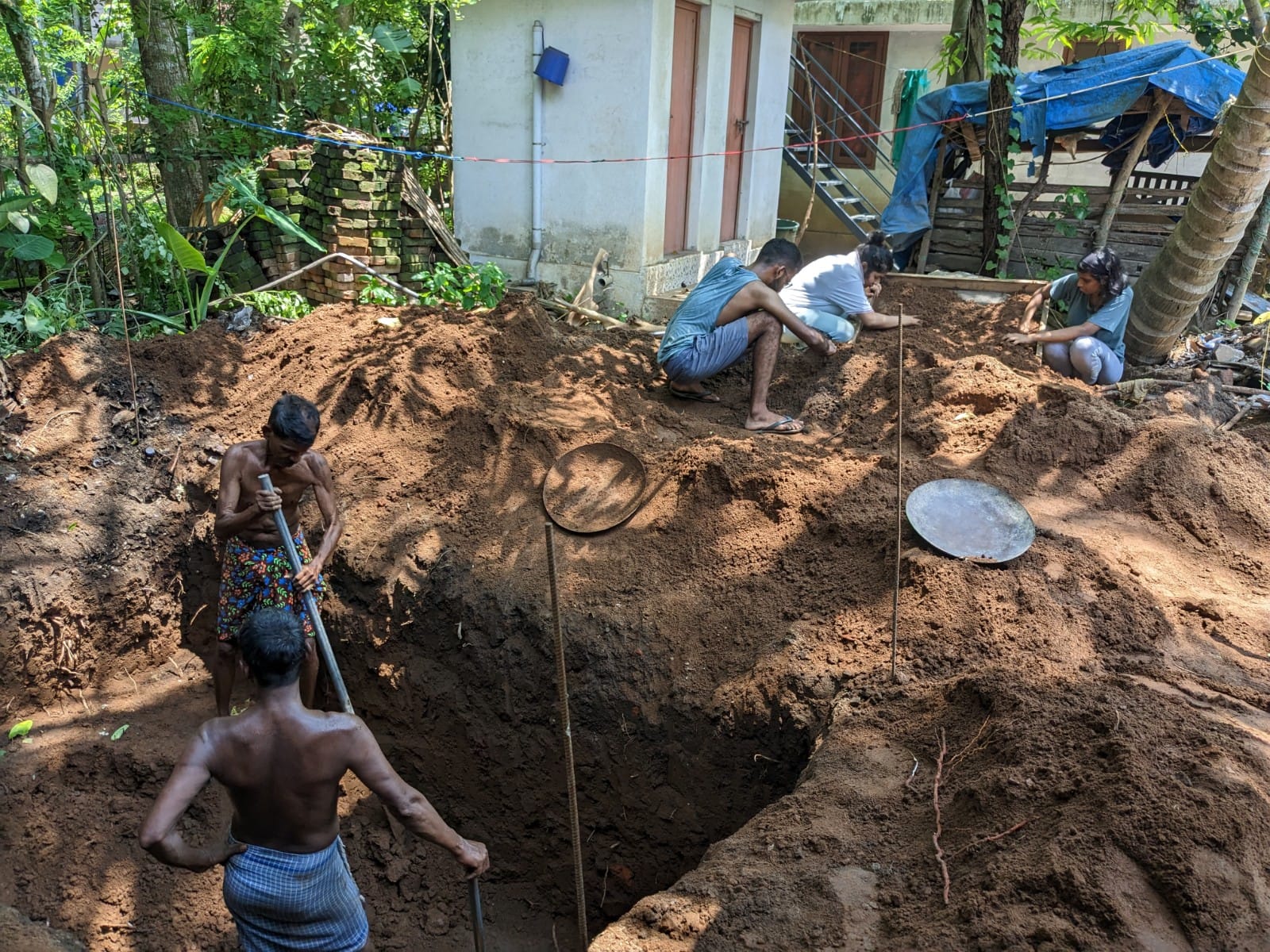
Interns with collected archaeological materials from a nearby dig for water pipe construction (left). Sorting through soil for archaeological materials from the earth dug for construction of a new septic tank (right).
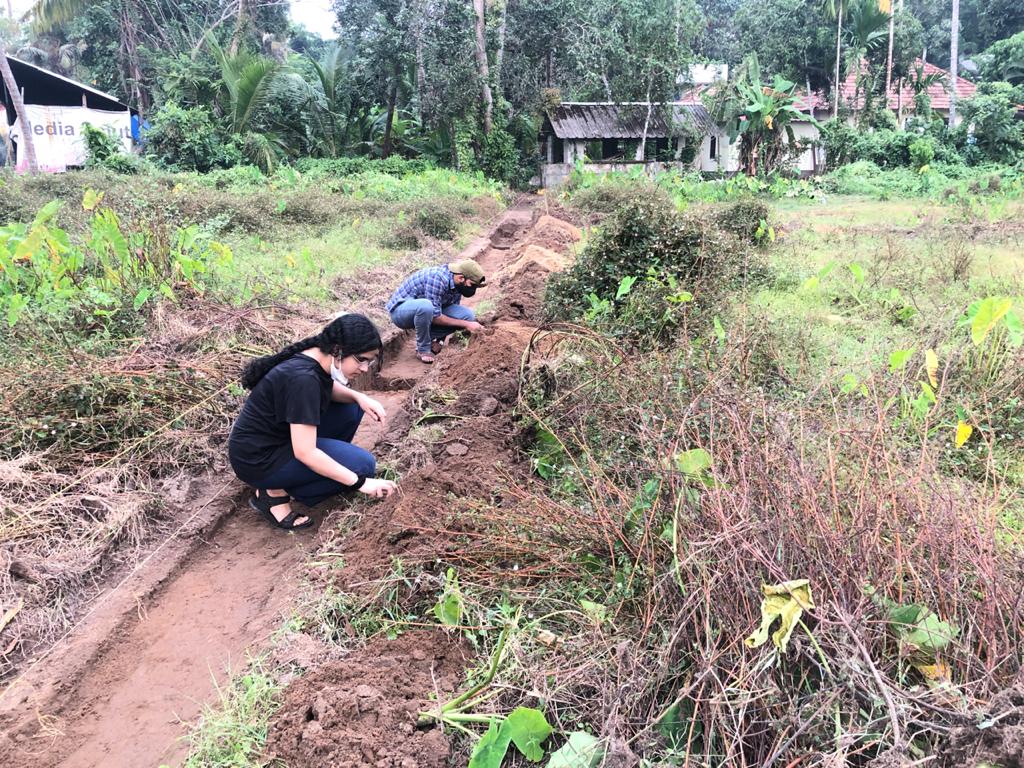
Interns searching for materials in a construction site in Pattanam
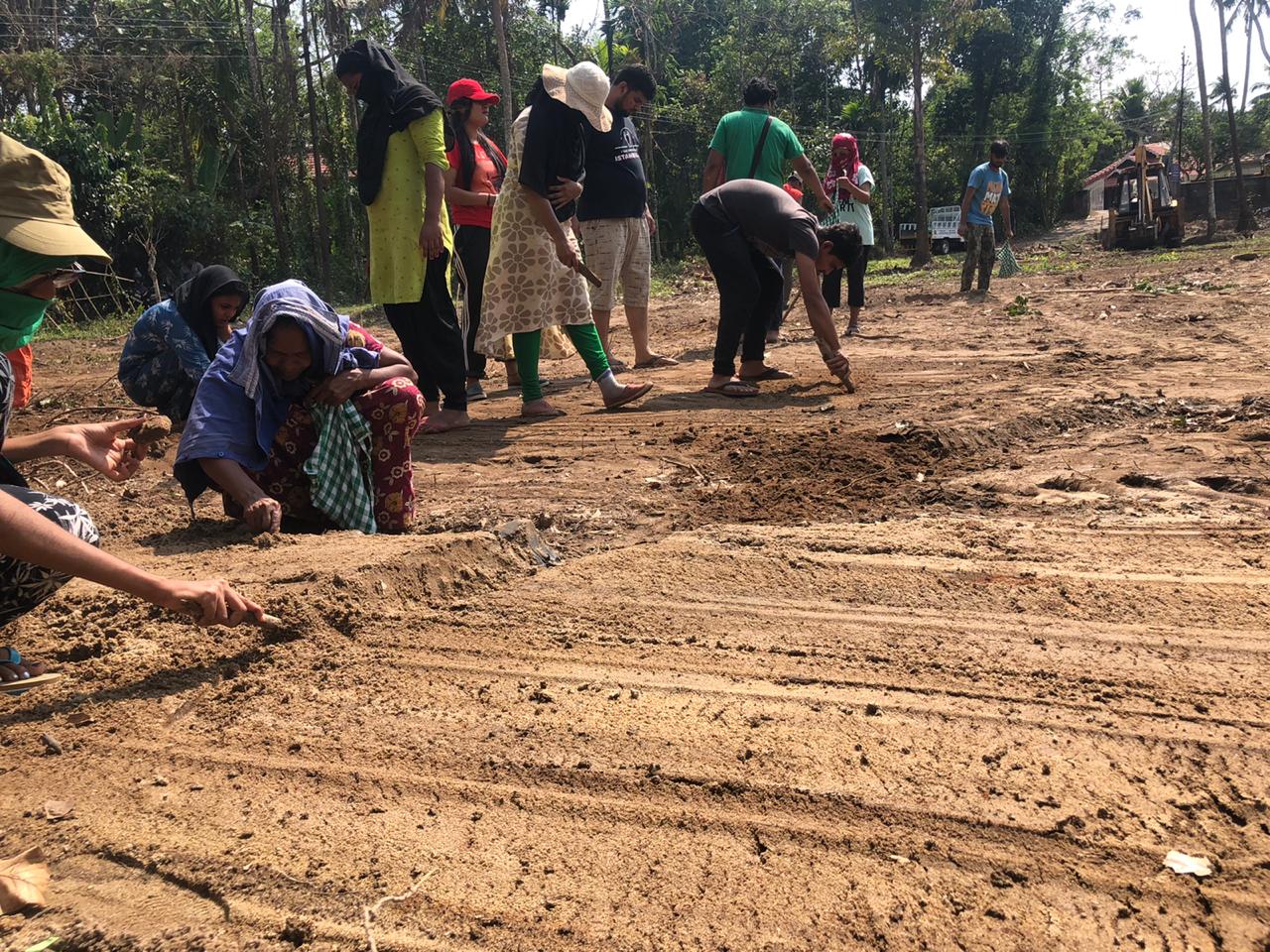
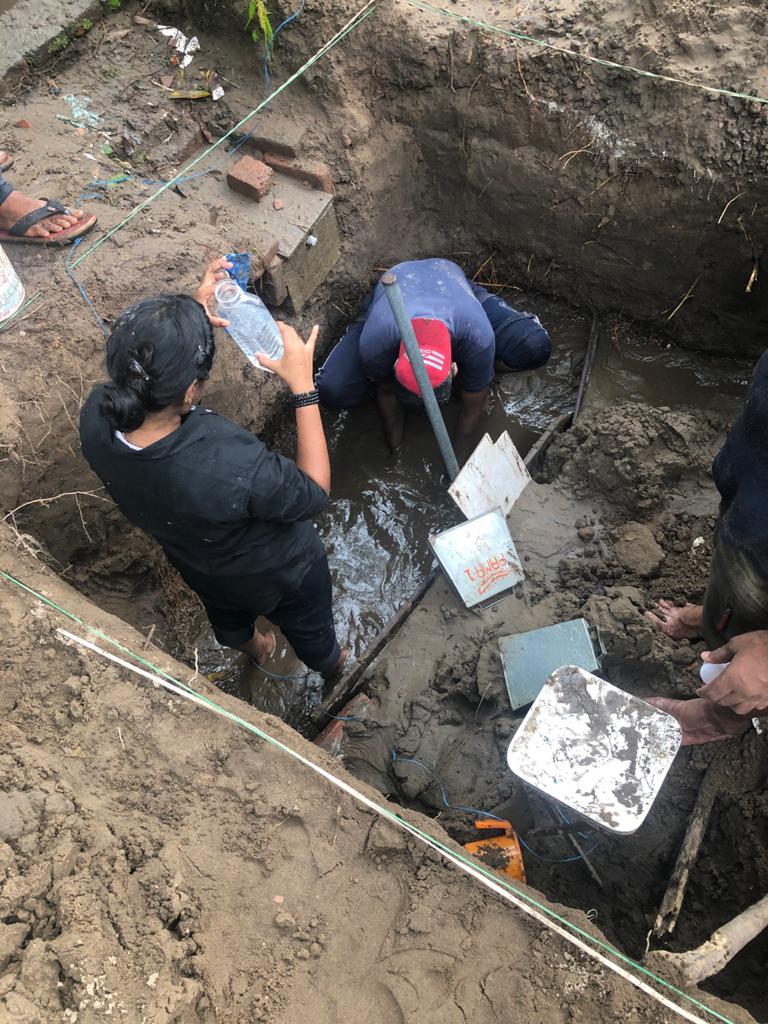
Sweeping through a newly cleared ground looking for traces of archaeological materials.
The Pattanam Salvage Archaeology Project, initiated upon request and in response to chance finds, focuses on preserving and studying archaeological vestiges from the Pattanam site, which is frequently affected by land intrusive activities. Given that the primary deposition layer of the Pattanam mound is often less than 1 metre beneath the surface, these layers are vulnerable to disturbance. Consequently, materials are sometimes left exposed due to various human activities.
This project not only involves the swift action necessary to protect these cultural relics but also seeks to create awareness among local populations about the importance of preserving archaeological heritage. The materials recorded and locational data collected through these efforts contributes to a comprehensive database that aids in understanding the broader extent of material deposits at Pattanam.
In line with the Indian Constitution's Section 51A (f & h), which underscores the responsibility of every citizen to protect cultural heritage and foster a spirit of inquiry and reform, the Pattanam Salvage Archaeology Project endeavours to document and safeguard the archaeological legacy of the site amidst ongoing development pressures.
Help PAMA protect Kerala’s heritage.
You can inform us about any chance findings of archaeological significance and we will provide assistance in identifying and preserving them following the necessary legal protocols. Contact us


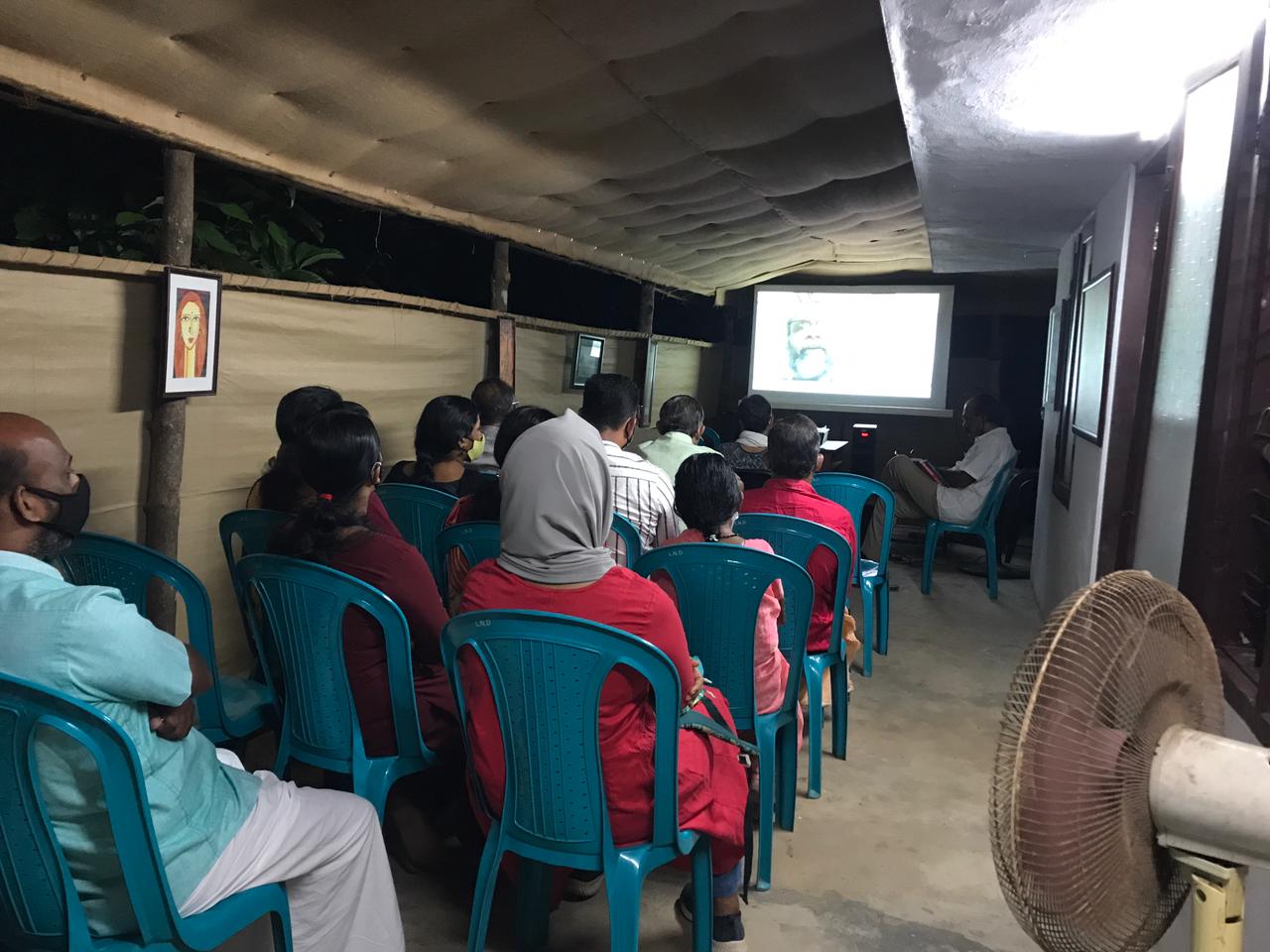
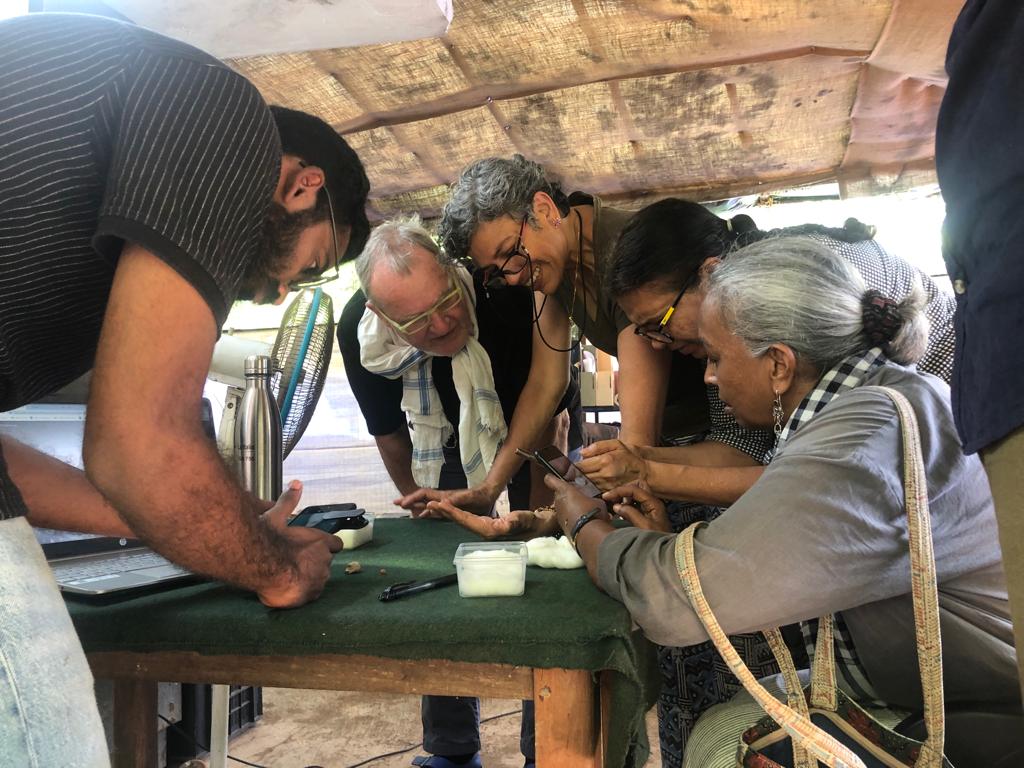
PAMA through various educational initiatives aims to sensitise all age groups to the excitement of evidence based journeys into the past.
We hope to disseminate the significance of Pattanam findings and their contemporary relevance and to make its inquiries and research in diverse
fields accessible to the public through its initiative. We encourage families, school and college mates, resident associations to visit PAMA centre
Bappukudi at Pattanam archaeological site.
PAMA will be happy to assist your logistical requirements at the bare minimum costs.
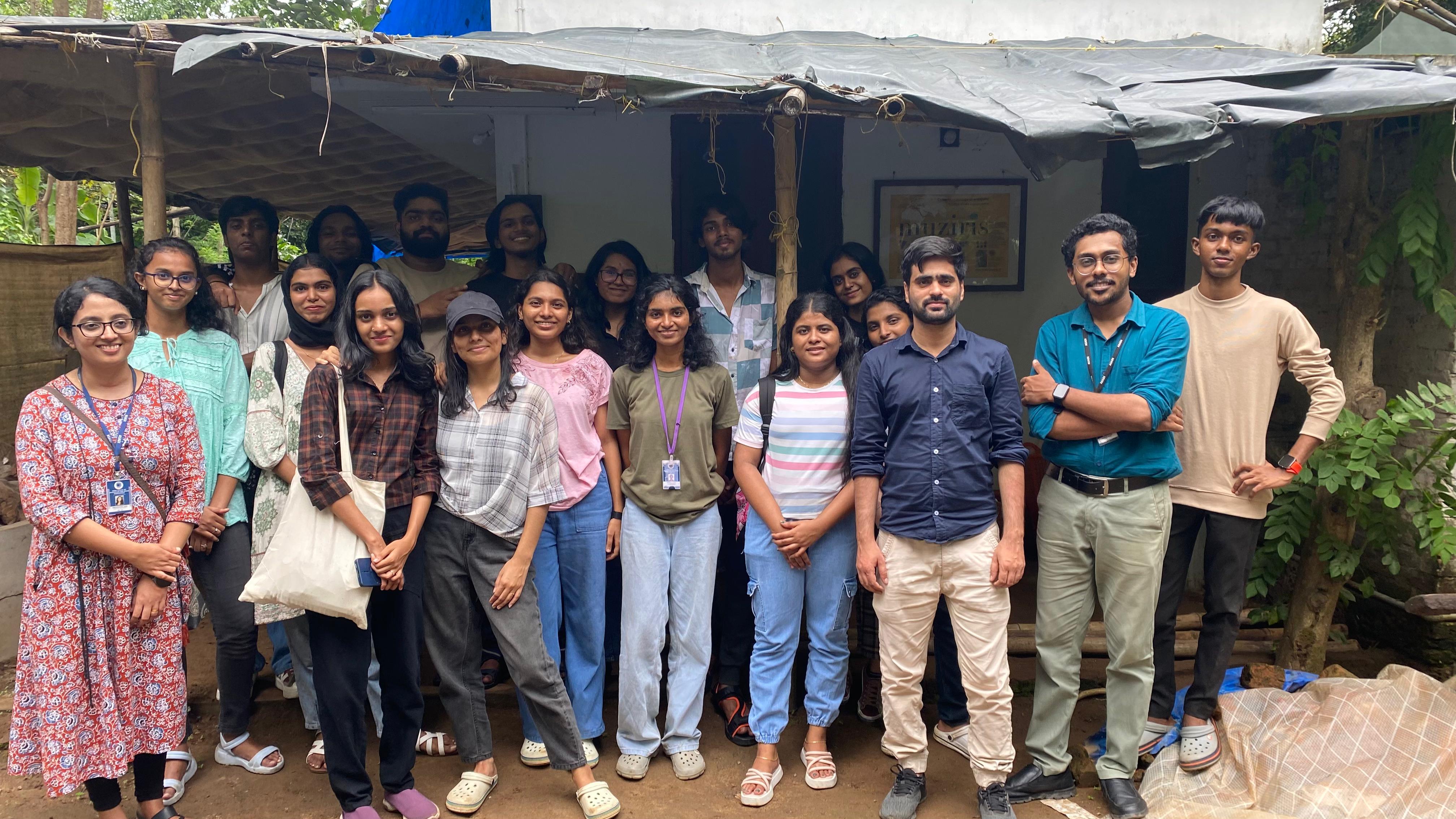
Students and faculty of Asian School of Architecture and Design Innovation at PAMA (Bappukudi) with our residential intern Mr Asad Sayed for the taster class.
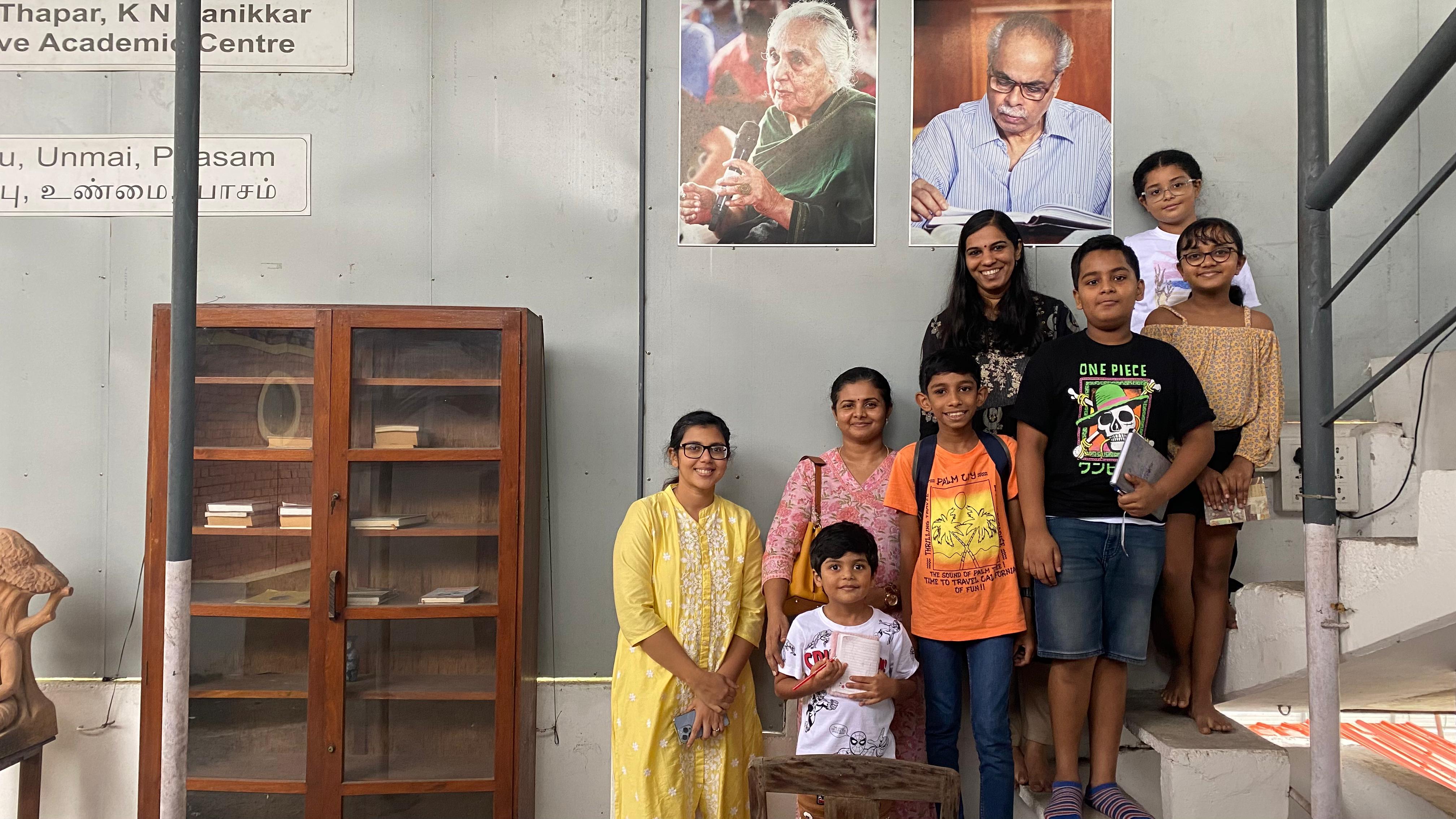
A group of young enthusiasts and their mothers attending taster class at PAMA RTKN Creative Academic Centre in Aluva.
Image: Sanjoe Joseph
Taster class is an opportunity for knowledge seekers to engage with our researchers and experts, to learn about our work and the various fields of PAMA’s enquiries and knowledge production.
Topics:
Kerala’s Sangam Age (300 BC to 300 AD), Muziris and Contemporary Ports, Transoceanic trade network (500 BC to 500 AD), Technology, State, Market and Religion as reflected in Pattanam Archaeological Record, Opportunities in transforming Pattanam village into a World Heritage Site, Green Archaeology initiatives, Imaginerims, and Entrepreneurial initiatives
Locations:
One-day Taster Classes at Romila Thapar & KN Panikkar Creative Academic Centre in Aluva, including field visits to the Pattanam archaeological site near North Paravoor, Ernakulam district. These sessions besides introducing the archaeological site of Pattanam aim to help transform Pattanam into an international knowledge centre and a model heritage site through cooperative entrepreneurial opportunities
Target Audience:
These introductory sessions are designed for aspiring, ongoing, or qualified graduates, postgraduates, and researchers across disciplines, careers, and employment-seeking youngsters, or even retired individuals.
Group Size:
Designed for groups of five to fifteen applicants.
Accessibility:
Free and open to all.
Form a group of minimum participants from among past or present classmates, hostelmates, colleagues, friends,
family or residential associations, or any institution with serious interest and possibly some follow-up goals.
Inform the details in the email address below.
Goals:
Knowledge Enhancement:
Provide foundational knowledge of Kerala’s Classical Age.
Skill Development:
Foster research and analytical skills through hands-on activities.
Entrepreneurial Opportunities:
Highlight potential in heritage tourism and cultural industries.
Participants will gain valuable insights into Kerala's rich archaeological heritage, positioning Pattanam as a beacon of knowledge and innovation.
Kerala in the Classical Age 500 BCE. - 500 CE. is a project aimed to introduce and educate knowledge seekers and the public to the little known history and its sources of the ancient south western region of the Indian subcontinent, which is present day Kerala.
The written sources of the Classical age was an online class on the Sangam literary corpus conducted successfully between December and March of 2022/23, by Vaidehi Herbert and Dr. K V Balasubhramaniam with more than hundred participants registered for the classes. The aim of the program was to introduce the participants to the Sangam literary corpus and its lesser known aspects. Click here
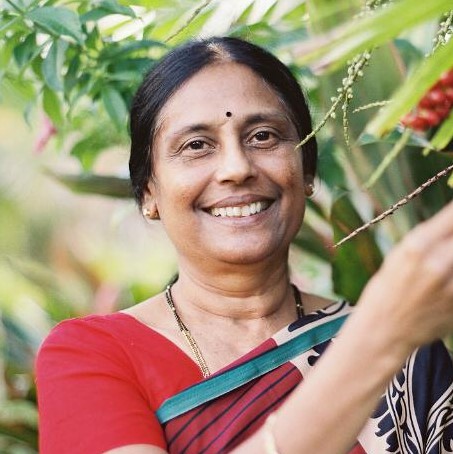
Vaidehi Herbert - has translated all the 18 ancient Sangam books and 10 post-Sangam works from old Tamil to English. She has been teaching Sangam literature for the past 7 years. She lives in Hawaii, U.S.A. She has won several awards and accolades for the services she rendered to classical Tamil language and culture.
This site provides free access to her translations of the eighteen Sangam books,
https://sangamtranslationsbyvaidehi.com/
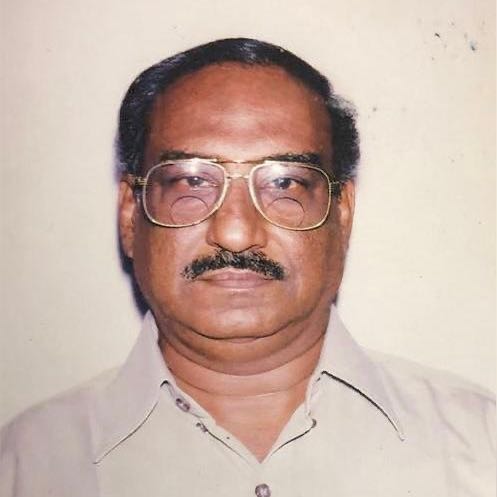
Dr. K.V. Balasubramanian is a renouned scholar of Tholkaappiyam, Sangam literature, Thirukkural, Silappathikaaram, Manimekalai, Bhakthi literature and more. He has authored 108 books. He is also a researcher and a prolific poet. He has taught at various universities including the Thanjavur Tamil University. Many of his books are included in the curriculum of Tamil universities and schools. He has received many awards and recognition for his phenomenal contributions to Tamil literature. Since retirement, he has been teaching Silappathikaaram and Thirukkural in Thanjavur and writing on different aspects of Sangam literary corpus.
Living in the digital times, we are flooded with photographic images – our everyday communication is constantly punctuated and often driven by visuals, captured through umpteen cameras, not the regular cameras as earlier, but those in our iPads, tablets, or most predominantly, mobile phones.
But a photographic image meant a totally different artefact, process and experience a few decades ago. Every small village or town, leave alone cities, had a studio that met the photographic needs of the locality – passport size photographs for official/legal purposes, photos of various family functions, religious rituals, festivals and public events of all kinds were photographed by them. In time, these photo studios grew into a rich archive of photographic materials of that region or locality, village or town – a virtual repository of images of all the major events and functions, personalities and institutions in that area. In many cases, such images were kept and preserved by photographers, families and institutions in the form of albums or framed pictures, though today most of them are lost or destroyed by the ravages of time
This project, in the first phase, aims to salvage, preserve, document and archive the photographs/negatives that are available with old studios in Kerala. Though many of the old studios have closed shop, there still exist many studios that have migrated successfully into the digital era. There are also instances where some studios and photographers have taken care to store and preserve the old negatives in their custody.
The project also aims to salvage, document and conserve the photographs/negatives in the possession of individuals, fa milies and institutions focusing in a specific administrative area like a ward or a select area of a Panchayat/Municipality.
For full details of the project, joining the research team etc; Colleges, Local Self Governments, Cultural organizations, local history enthusiasts, researchers and students can contact the Principal Investigator of the project by writing to PAMA.
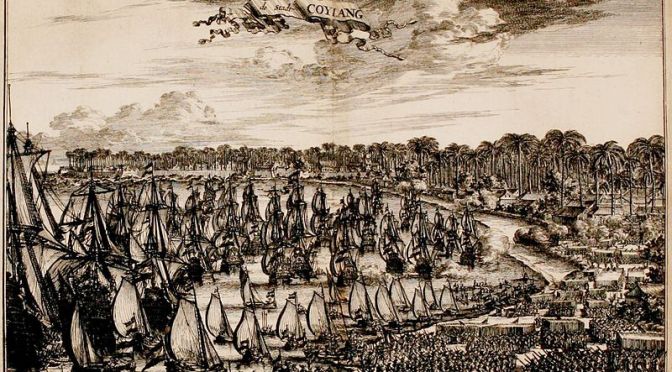
Archaeo-biological finds hold the key to many questions related to our past, present and future. They are a treasure of information pertaining to varied forms of life in their environmental entirety.
Archaeo-biological finds hold the key to many questions related to our past, present and future. They are a treasure of information pertaining to varied forms of life in their environmental entirety. They can elicit information with regard subsistence and exchanges ranging from hunting-gathering, agricultural practises, food habits, religious practices, shipping, industrial practices etc. It can be prised open only through advanced inter-disciplinary analytical studies.
Painstaking excavations carried out over a number of seasons at Pattanam, on the south-western coast of the Indian sub-continent and at Berinike, the Red Sea Port of Egypt have unearthed a plethora of botanical remains. The archaeobotanical remains of Pattanam included both Indian and non-Indian varieties like black pepper, cardamom, frankincense, rice, pulses, leaves, wood, charcoal, etc. The Berenike site located in an arid region with its better preservation conditions have thrown open a much richer variety of botanical remains. Berenike being the destination port of the vessels from the Malabar Coast, these archaeobotanical remains are critical evidence for understanding the maritime history of this period. It further corroborates with the much lauded written sources that pepper was the mainstay of the spice trade between Kerala region and the Mediterranean.
PAMA envisages to undertake morphological and characterisation studies of archaeo-botanical finds from these two contemporary sites. The studies on the peppercorn finds and other spices unearthed at Berenike using conventional tools and Archaeo-molecular techniques will yield valuable information on the first trans-oceanic connections in human history. DNA analysis using fingerprinting and RAPD marker techniques will hopefully throw light on the pepper and spice varieties traded. It will reveal to us the varieties that were exported from the Malabar region. It will also be of great scientific interest to know if the varieties traded were of the farm origin or semi wild varieties. Comparison with varieties grown today will give us a glimpse into the farming practices in the Malabar region more than 2000 years ago !
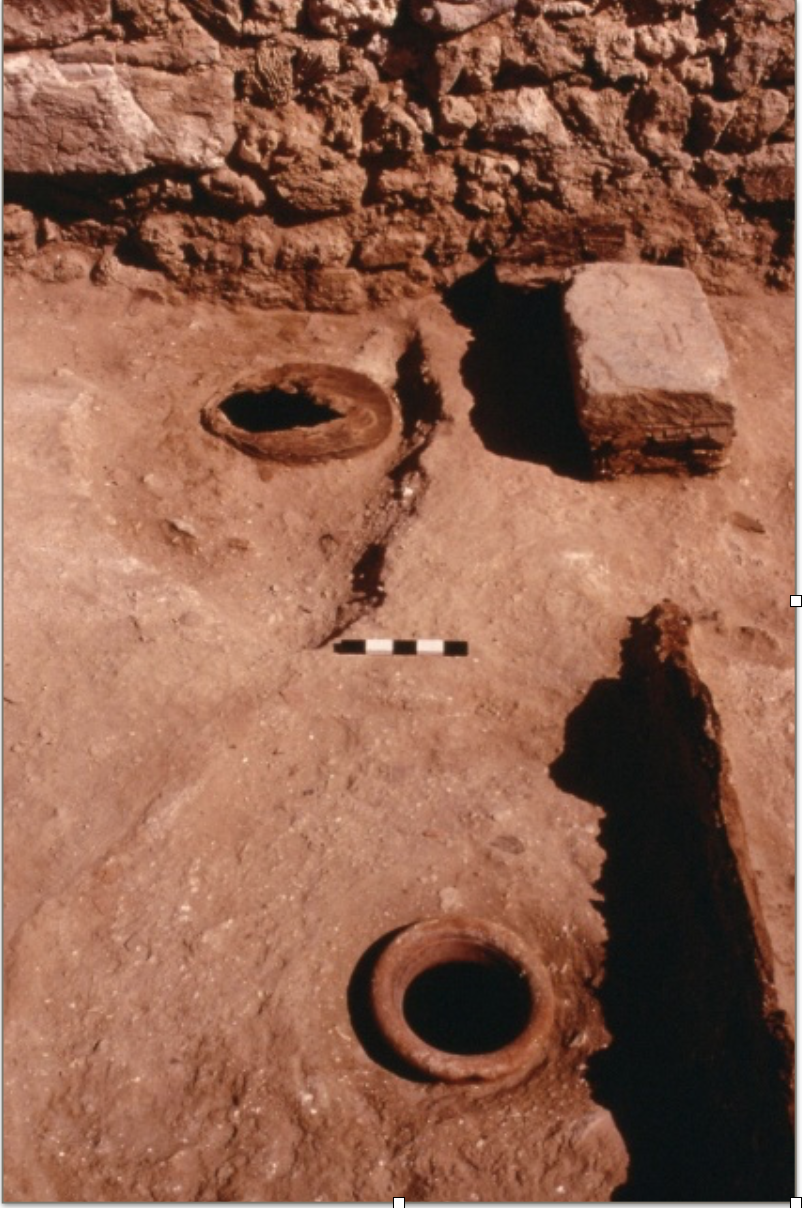
Two Indian made large pots buried at the floor of the Serapis temple at Berenike contained 7.5 kg of black pepper.1
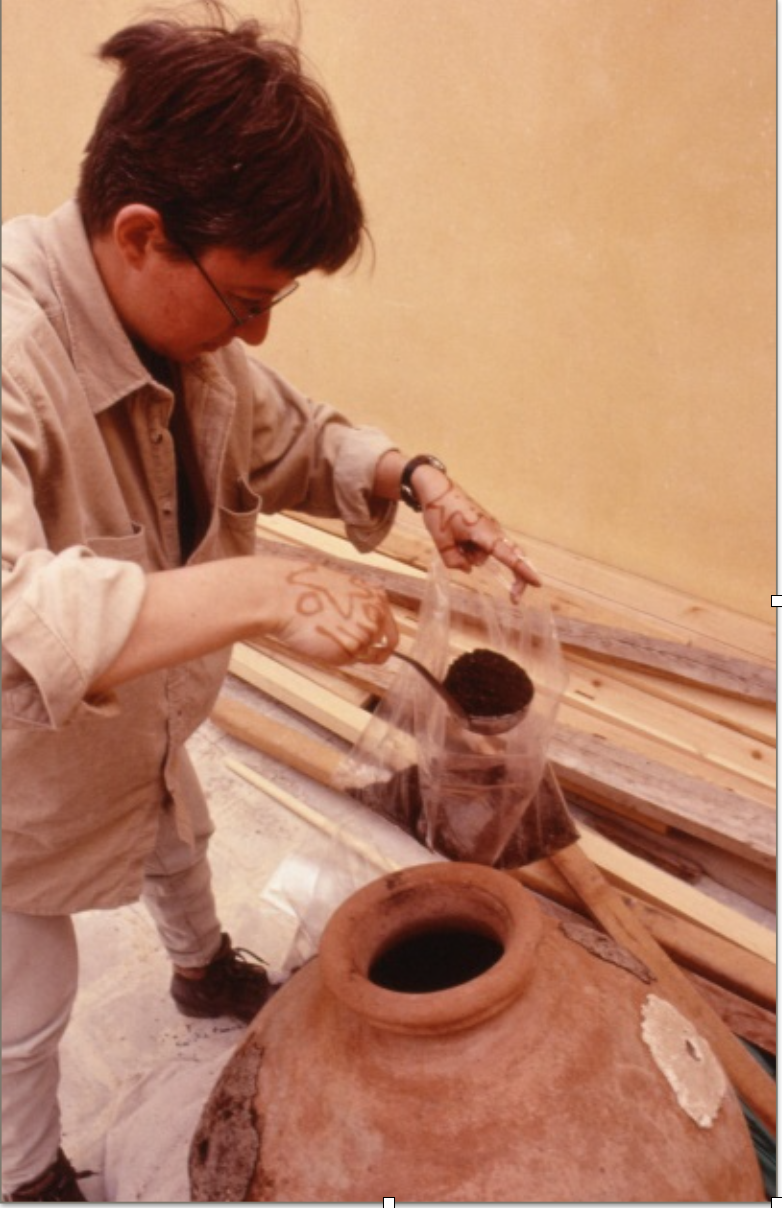
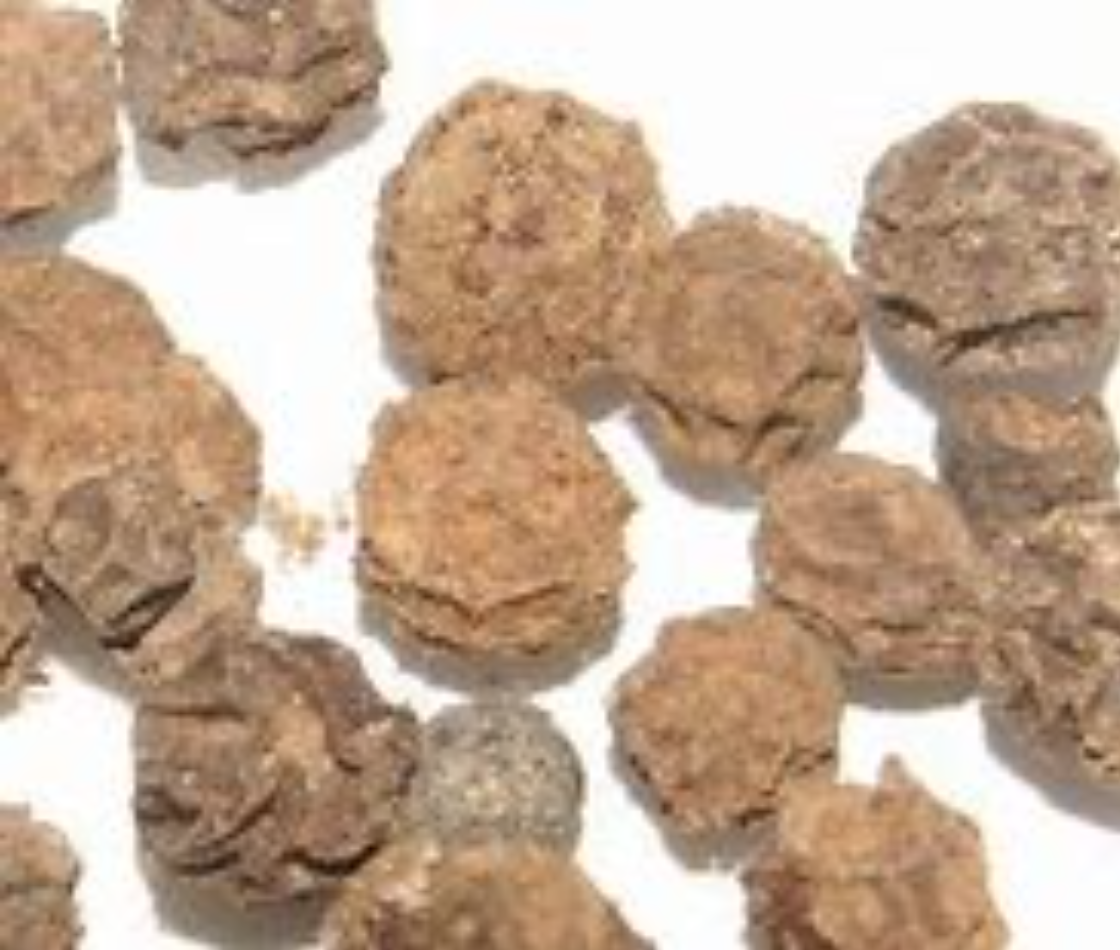
Black Pepper
PAMA Research Centre (Bappukkudi),
Pattanam, Vadakkekara P. O,
North Paravoor, Ernakulam,
Kerala, 683522
Google Map
PAMA Research Centre,
(PAMA Parayil),
83/Periyar Gardens GCDA Road, Thottakkattukara PO
Aluva, Kerala, 683108.
Google Map
Phone number - +91 98474 49495
Whatsapp - +91 98474 49495
9544049495
Email - pamatatas@gmail.com